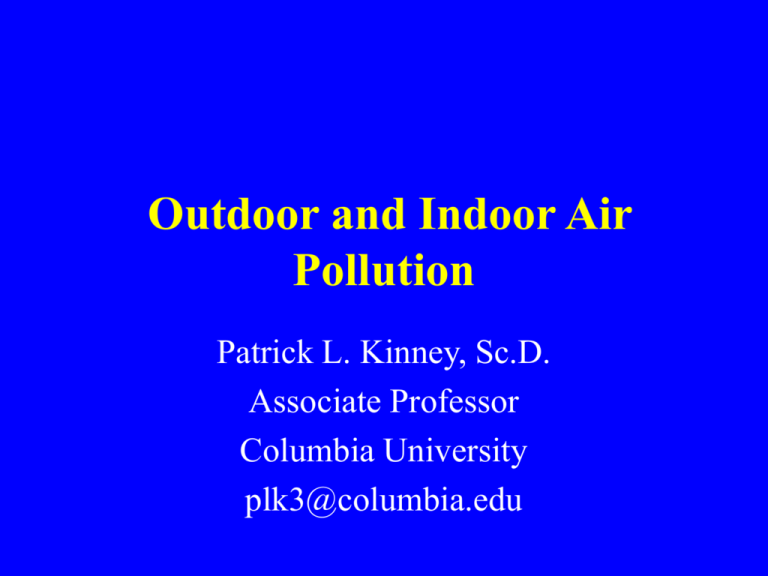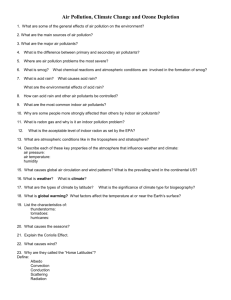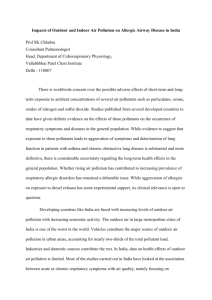KinneySlides - Columbia University
advertisement

Outdoor and Indoor Air Pollution Patrick L. Kinney, Sc.D. Associate Professor Columbia University plk3@columbia.edu Overview • • • • • • The natural atmosphere Outdoor pollutants and their sources Indoor air pollution Health effects of air pollution Measurement of particle pollution Climate change Vertical structure of the atmosphere Troposphere • Lowest 10 km of atmosphere • Contains 75% of the atmospheric mass • The layer in which most weather phenomena occur, e.g., frontal passage, storms, winds • The layer in which most air pollution problems occur • Energy balance is key factor Distribution of incoming solar radiation 30% reflected back to space About half absorbed by surface Air set in motion by: • Absorption of energy at surface followed by transfer of heat to lowest layer of air • Heated parcels become buoyant relative to nearby cooler parcels, thereby rising • Rising of air parcel leaves lower pressure at surface • Dense, cool air moves towards the area of low pressure • Pressure gradient force drives winds As a warm parcel rises, it expands and cools, resulting in the “normal lapse rate” (– 6.5 ºC/km) of troposphere depicted here. When the temperature lapse rate becomes “inverted” near the surface in urban areas, high pollution levels are likely to result A Typical Morning in Denver, Colorado Worst Case: Inversion in a Valley Air Pollutants of Human Health Concern • • • • • • Carbon monoxide Sulfur dioxide Nitrogen dioxide Volatile organics Ozone Particulate matter – Sulfates, nitrates, organics, elemental carbon, lead and other metals Carbon Monoxide - CO • Colorless, odorless gas • Primary pollutant, emitted by incomplete combustion of biomass or fossil fuels • Binds strongly with hemoglobin, displacing oxygen • Emissions reduction by higher temperature combustion and use of catalytic converters on motor vehicles Sulfur Dioxide – SO2 • Primary pollutant, emitted by combustion of fuels containing sulfur; also metal smelting • Irritates upper respiratory tract • Converted in atmosphere to acid sulfates • Emissions reductions by building taller smoke stacks, installing scrubbers, or by reducing sulfur content of fuel being burned Acid Precipitation Formation Nitrogen Dioxide – NO2 • Formed by oxidation of NO, which is produced with high temperature combustion (NO2 is a secondary pollutant) • Oxidant that can irritate the lungs and hinder host defense • A key precursor of ozone formation • Emissions reductions by engine redesign and use of catalytic converters Volatile Organic Compounds VOCs • Products of incomplete combustion, evaporation of liquid fuels, atmospheric reactions, and release from vegetation (both primary and secondary) • Wide range of compounds with varying health effects • Another key ozone precursor • Emissions reductions by high temperature combustion and control of evaporation, e.g., during refueling of cars Ozone – O3 • Secondary pollutant, formed via photochemical reactions in the atmosphere from NOx and VOC in the presence of sunlight • Strong oxidant that damages cells lining the respiratory system • Concentrations often highest downwind of source regions • Emissions reductions by control of NOx and VOC emissions, especially from motor vehicles Mechanisms of Ozone Formation Regional Air Pollution Mechanisms e.g., Ozone and Acid Precipitation Particulate Matter - PM • Products of combustion, atmospheric reactions, and mechanical processes • Wide range of particle sizes • Wide range of physical/chemical properties • Wide range of health impacts, including premature death • Control by filtration, electrostatic precipitation, and reduction of precursor gases Distribution of particle mass at various particle diameters for a typical urban air sample Particle size distributions differ in urban and rural areas Particle deposition in the respiratory system is a strong function of particle diameter Motor Vehicles represent a major source category for several air pollutants (CO, NO2, VOCs, O3, PM) Figure 3.2 Trends in estimated U.S. Lead Emissions 250,000 150,000 100,000 50,000 0 1970 1975 1980 1985 1990 1993 1994 Year Fuel Combustion Metals Processing Other Industrial & Allied Mfg WasteDisposal& Recycling Non-road Vehicles On-road Vehicles Short Tons 200,000 Figure 3.3 Trends in U.S. Ambient Lead Concentrations 1.6 NAAQS 1.5 ug/m3 1.2 1 0.8 0.6 0.4 122 Sites 208 Sites 0.2 0 19 77 19 78 19 79 19 80 19 81 19 82 19 83 19 84 19 85 19 86 19 87 19 88 19 89 19 90 19 91 19 92 19 93 19 94 19 95 19 96 Pb, Max. Qtr. ug/m3 1.4 Year Indoor Air Pollution • Combustion is principal source: cooking, smoking, heating • Dilution and dispersion are limited, especially nearest the source • Pollutants of greatest importance include: CO, NO2, PM, VOCs • Indoor concentrations often far higher than outdoors, even in urban areas • Those who spend the most time indoors near the source will be most impacted The most local form of air pollution: indoor combustion of biomass in India •About half the world ’s households use unprocessed solid fuels for cooking,ranging roughly from near zero in developed countries to more than 80%in China,India,and SubSaharan Africa (Holdren et al.,2000). •In simple small-scale devices,such as household cookstoves, solid fuels have rather large emission rates of a number of important health-damaging airborne pollutants including respirable particulates,CO,dozens of PAHs and toxic hydrocarbons,and, depending on combustion and fuel characteristics, nitrogen and sulfur oxides. •A large,although uncertain,fraction of such stoves are not vented,i.e.do not have flues or hoods to take the pollutants out of the living area. •Even when vented to the outdoors,unprocessed solid fuels produce enough pollution to significantly affect local pollution levels with implications for total exposures (Smith et al.,1994).As cookstoves are essentially used everyday at times when people are present,their exposure effectiveness (or intake fraction)is high,i.e.the percentage of their emissions that reach people ’s breathing zones, is much higher than for outdoor sources(Smith, 2002; Bennett et al.,2002). •The individual peak and mean exposures experienced in such settings are large by comparison with WHO guidelines and national standards. From: Kirk Smith, Indoor Air 2002;12:198 .207 For comparison: US annual PM2.5 standard is 15 ug/m3 Table 4.3. Indoor particle air pollution from biomass combustion in developing countries: partial list of studies of individual breathing area concentrations (women during cooking, unless otherwise stated) (Smith 1996). Albalak R. et al., Environ. Sci. Technol. 2001, 35, 2650-2655 Health Effects of Air Pollution • Historical experience provides strong evidence for causal relationship between air pollution and premature death • Modern epidemiology studies have consistently found significant associations • Two primary epidemiologic study designs: – Time series studies of acute effects – Cohort or cross-section studies of chronic effects • Let’s look at the evidence for particle health effects… London Killer Fog, December, 1952 London Mid-day in December 1952 Air Pollution Epidemiology • Provides most directly relevant results for policy makers • Assesses effects of real mix of pollutants on human populations • Pollutants tend to co-vary, making it hard to distinguish effects • Can demonstrate associations between outcome and exposure, but not cause and effect • Must control for confounding factors • Exposure assessment is “ecologic” Time Series Epidemiology • Addresses effects in narrow time window • Involves multiple regression analysis of long series of daily observations • Large number of studies have reported significant associations between daily deaths and/or hospital visit counts and daily average air pollution. • Time series design avoids spatial confounding; however, temporal confounding due to seasons and weather must be addressed. • Particles often appear most important, but CO, SO2, NO2, and/or ozone may also play roles. • For example, NMMAPS Study Cohort Epidemiology • Address long-term exposure-response window • Large populations in multiple cities enrolled and then followed for many years to determine mortality experience • Cox proportional hazards modeling to determine associations with pollution exposure • Must control for spatial confounders, e.g., smoking, income, race, diet, occupation • Assessment of confounders at individual level is an advantage over cross-sectional, “ecologic” studies Pope, C.A. et al., Journal of the American Medical Association: 287, 1132-1141, 2002 Pope, C.A., et al., Conclusion • “Long-term exposure to combustionrelated fine particle air pollution is an important environmental risk factor for cardiopulmonary and lung cancer mortality.” Human Health Effects of Airborne Particulate Matter • Daily time-series studies have demonstrated small but consistent associations of PM with mortality and hospital admissions, reflecting acute effects. • Acute effects on lung function, asthma exacerbations, and other outcomes • Multi-city prospective cohort studies have shown increased mortality risk for cities with higher long-term PM concentrations, reflecting chronic effects. Implications • Acute effects are well documented but of uncertain significance • Chronic effects imply very large impacts on public health. • A new US national ambient air quality standard for PM2.5 was established in 1997, largely based on the cohort epidemiology evidence • Mechanistic explanation for chronic effects remains unclear • Weaknesses in exposure assessment limits interpretation Acute Chronic It is also unclear… • Whether a threshold exists • Who is at risk due to – Higher exposures – Greater susceptibility • What particle components are most toxic • Which sources should be controlled Measurement of Airborne Particulate Matter • Getting the size right • A look at some field studies A typical impactor design for size-selective particle sampling onto a filter Variation on a theme – the Virtual Impactor Diesel Traffic and Air Pollution Study Truck and Bus Counts at Four Harlem Intersections (Kinney et al., Environ. Health Perspec., 2000) Truck 8-hr Vehicle Count 1600 Bus 1403 1400 1200 1064 1000 800 529 600 403 400 200 45 13.5 75.5 28 0 Edgecombe Ave 133 St. Bus Depot Harlem Hospital Intersection 125St., Amsterdam Ave Mean Elemental Carbon Concentrations at Four Harlem Intersections 7 1. Amsterdam Ave 6 5 4 2. Bus depot 3 3. Harlem Hospital 2 4. Edgecombe Avenue 1 0 0 500 1000 1500 Diesel Vehicle Counts 2000 2500 Air Toxic Exposures of High School Students, the TEACH Study Close-up of personal sampling backpack Upwind site Urban site Analysis of Particle Samples • Mass determined by weighing Teflon filter before and after sampling under controlled conditions • Elemental carbon estimated by light absorption • Analysis of trace elements by ICP-mass spectrometry NY Summer PM2.5 Upwind fixed site Urban fixed site Home outdoor 48 PM2.5 (µg/m^3) 36 24 12 0 6/23/99 7/7/99 7/21/99 8/4/99 Date 8/18/99 9/1/99 NY Summer Sulfate Upwind fixed site Urban fixed site Home outdoor 30000 Sulfate (ng/m^3) 25000 20000 15000 10000 5000 0 6/23/99 7/7/99 7/21/99 8/4/99 Date 8/18/99 9/1/99 NY Summer Absorbance (Black Carbon) 5 Upwind fixed site Urban fixed site Home outdoor Abs* ((1/m) x 10^5) 4 3 2 1 0 6/23/99 7/7/99 7/21/99 8/4/99 Date 8/18/99 9/1/99 Winter NYC Individual Data: Indoor and Outdoor vs. Personal Absorbance 5.0 Indoor Abs 4.0 Absorbance Outdoor Abs 3.0 2.0 1.0 0.0 0.0 1.0 2.0 3.0 Personal Absorbance 4.0 5.0 104 summer median 103 winter median 102 101 100 10-1 10-2 10-3 10-4 Pt Be Cs Tl Sc Ag Cd As Cr La Co Sn Se Sb Mn Cu Ti V Pb Ni Zn Mg Ca Al K Na Fe SO4 PM2.5 3) Median Ambient Concentration (ng/m 105 Element Median concentrations at urban fixed site, NYC winter and summer Fe NY Winter 1000 1784 95th 75th Me d ng/m^3 750 25th 5th 500 250 0 Personal Home Indoor Home Urban Upwind Outdoor Fixed-site Fixed-site Mn NY Winter 20 95th 75th Me d 15 ng/m^3 25th 5th 10 5 0 Personal Home Indo or Home Outdoo r Urba n Fixed-site Upwind Fixed-site Fe vs Mn in particles, Winter 160 000 personal personal: y = 109x - 10422 upwind f ixed sit e 140 000 2 R = 0.98 urban f ixed site home outdoor Fe Fe as µg/g of PM2.5 mass 120 000 indoor crust al Fe/ Mn 100 000 personal t rendline 800 00 600 00 crust al Fe/ Mn = 55 400 00 200 00 0 0 400 800 Mn as µg/g of PM2.5 mas s 120 0 160 0 Elevated personal samples are consistent with steel dust in subway air! Preliminary Conclusions • We see strong urban influences on air toxic exposures for some particle components. • Personal exposures are closely associated with outdoor concentrations of black carbon, an indicator of diesel exhaust particles. • Diesel particle exposures are associated with lung cancer and have been suggested to play a role in asthma. • New studies underway to examine the diesel/asthma link. Traffic-related Particle Exposures among NYC Children P. Kinney, PI Figure 1. Daily Black Carbon (BC) and Organic Carbon (OC) concentrations for FLH HS and Ramapo HS, Janurary 15, 2003-February 18, 2003 6000 FLH BC FLH OC 5000 Ramapo BC Concentration (ng/m3) Ramapo OC 4000 3000 2000 1000 0 1/13 1/15 1/17 1/19 1/21 1/23 1/25 1/27 1/29 1/31 2/2 Date 2/4 2/6 2/8 2/10 2/12 2/14 2/16 2/18 2/20 Urban Diesel Exposure and Inner City Asthma R. Miller, PI Objective: To assess geographic associations between diesel exposure and asthma development in a NYC birth cohort The Greenhouse Gases US greenhouse gas emission trends Air pollution and heat: the Ozone example Impacts of Climate Change • General warming; greater at poles; greater in winter • Sea level rise • Changing rainfall patterns • Greater variability and intensity of weather extremes – Longer and deeper droughts – More frequent and extreme storms Climate Change and Public Health • Changing patterns of rainfall will have profound effects on local agriculture, water supply, and well-being • Heat-related mortality and morbidity • Death and injury due to extreme storms • Changing patterns of vector-borne diseases • Air pollution • Ability to adapt will vary with income level Another aspect of energy balance: the Urban Heat Island Urban Heat Island in Atlanta Metro Area Urban Heat Island over Tokyo New York Climate and Health Project • How might health in the NY metropolitan region be affected by climate and land use change? Mailman School of Public Health: Patrick Kinney (PI) – Public health impact analysis Goddard Institute for Space Studies: Cynthia Rosenzweig – Global and regional climate modeling LDEO: Chris Small – Remote sensing Hunter College: Bill Solecki – Regional land-use/land-cover modeling SUNY Albany: Christian Hogrefe – Regional air quality modeling Duke University: Roni Avissar – Regional climate modeling IPCC A2, B2 Scenarios Global Climate Model NASA-GISS meteorological variables NY Climate & Health Project Regional Climate reflectance; stomatal resistance; surface roughness Land Use / Land Cover SLEUTH, Remote Sensing ClimRAMS MM5 meteorological variables: temp., humidity, etc. heat Public Health Risk Assessment Ozone PM2.5 IPCC A2, B2 Scenarios Air Quality MODELS-3







